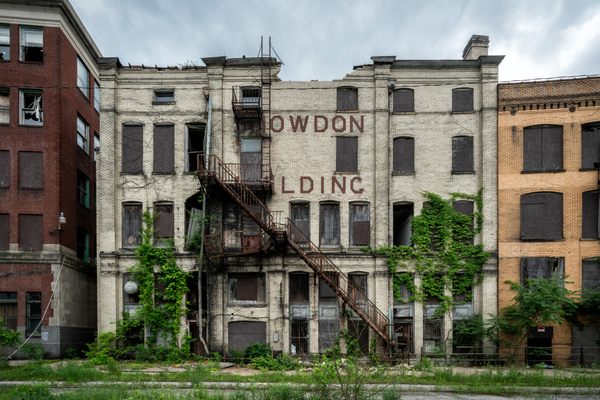A Photographer Finds the Ghost of Woody Guthrie in an Abandoned Asylum
Inside Greystone Hospital (photograph by Phillip Buehler)
In the legend of folk icon Woody Guthrie, his final 15 years as a hospital patient tormented by Huntington’s Disease are often forgotten. The vibrant musician from Oklahoma boiled over with hundreds of songs of worker empowerment, and odes to the downtrodden burst from his guitar slapped with the words: “This Machine Kills Fascists.” His “This Land Is Your Land” is practically an alternative populist national anthem. Yet his final years are also a part of who he was, even as his mental and physical abilities deteriorated with the degenerative hereditary disease so that he couldn’t even hold a guitar.
Photographer Phillip Buehler set out to document the abandoned Greystone Park Psychiatric Hospital in Morris Plains, New Jersey, where Guthrie was a patient from 1956 to 1961. Buehler has been photographing “modern ruins” for decades, and wanted to document this old 19th century ruined building before it faded from memory.
Photographer Phillip Buehler
“When Woody’s story has been told, it has usually ended when he stopped performing,” Buehler told Atlas Obscura. “His Huntington’s Disease and hospitalization were rarely mentioned. But he was still alive, he was still writing, he was still influencing people like Bob Dylan. And just like Woody, these decaying buildings at Greystone still hold meaning.”
The imposing main building at Greystone is up for demolition. Opened in 1876, it was until the Pentagon the most massive American poured concrete structure. Woody’s daughter Nora Guthrie, who has argued that Greystone Park Psychiatric Hospital should be preserved, collaborated with Buehler on the recently published Woody Guthrie’s Wardy Forty: Greystone Park State Hospital Revisited. The book compiles together over 70 of Buehler’s photographs of the hospital along with Guthrie family photographs, letters, and other materials from the Woody Guthrie Archives. Valentine Gallery in Queens is also currently exhibiting Buehler’s photographs through April 13.
Buehler’s images of Greystone are haunting, perhaps more for their quiet than anything creepy. Hospital beds are empty, an old piano is silent among the peeling paint, winter snow has fallen in the hallways. Guthrie’s mother had also been institutionalized in a mental hospital for Huntington’s, and when Guthrie started to be impacted by its symptoms there was still not much known about the disease. So people with Huntington’s, including Guthrie, often ended up in psychiatric facilities. Guthrie, however, didn’t lose his wry spirit, calling the place “Gravestone” and his Ward 40 the “Wardy Forty.” One of his last songs proclaimed: “I Ain’t Dead Yet.”
“Buildings outlast us, so their preservation is important as they often hold the key to our memories,” Buehler explained. “Without the buildings on Ellis Island, would people still visit and learn about that period of American history? Unfortunately, the ruins of Greystone Park may not exist much longer.”
Buehler will be at Valentine Gallery this weekend from 1 to 3 pm Saturday and Sunday to answer questions and sign books which will be available for purchase.
Greystone Hospital (photograph by Phillip Buehler)
A hospital ward (photograph by Phillip Buehler)
Hair dryers (photograph by Phillip Buehler)
A faded artwork of a man with his guitar (photograph by Phillip Buehler)
Paint peeling on an open door (photograph by Phillip Buehler)
An abandoned piano (photograph by Phillip Buehler)
Greystone Hospital in winter (photograph by Phillip Buehler)
The exhibition at Valentine Gallery
The exhibition at Valentine Gallery
Woody Guthrie in 1943 (via Library of Congress)
Woody Guthrie’s Wardy Forty: Greystone Park State Hospital Revisited is available from Woody Guthrie Publications, Inc. Photographs by Phillip Buehler are on view at Valentine Gallery in Ridgewood, Queens, NYC, through April 13.

















Follow us on Twitter to get the latest on the world's hidden wonders.
Like us on Facebook to get the latest on the world's hidden wonders.
Follow us on Twitter Like us on Facebook